Fashion, fibres and farming – steps to sustainability
 © Adobe Stock
© Adobe Stock As sustainability becomes a central concern not just for agriculture but also for consumers, a new “farm to wardrobe” movement is developing.
The fashion industry is responsible for 10% of the global annual carbon footprint, and fast fashion contributes 35% of the microplastics polluting our oceans.
Wearing sustainable clothes from wool, flax, hemp, and leather could become as everyday as buying free-range eggs, something which just a few decades ago was a niche part of egg production.
See also: Wool’s environmental credentials open new markets
Fashion helps us to confirm who we are, how we feel and what we value.
It’s about personal and group identity, and there is a growing movement among consumers against fast fashion and a turn towards quality and longevity.
Wool’s credentials as an eco-friendly material – breathable and biodegradable, and offering insulation and resilience – ensure that it is increasingly the choice of many clothing makers.
British farmers, textile producers, designers and eco-conscious consumers are joining forces to create a local fashion supply chain, from field to fabric to finished garment.
Beyond environmental benefits, the movement supports rural economies, preserves heritage crafts, and promotes supply chain transparency.
For farmers, it introduces new markets and adds value to traditional outputs.
As interest in provenance and sustainability deepens, farm to wardrobe offers an opportunity to reimagine British fashion from the soil up.
This also fits in well with a younger generation of farmers succeeding to their family businesses and bringing in approaches that show a raised awareness of health, the environment, and wellbeing.
In this growing movement, designers aren’t just end users of materials, they are facilitators, educators and collaborators, working to bring natural British fibres back into fashion.
All these efforts, across wool and leather, education and product development, share a common thread: they are producer and designer-led responses to a system in need of change.
These innovators are creating guides, platforms, partnerships, public showcases, and educational initiatives that support and celebrate British-grown fibres.
Case study: Fernhill Fibre, Somerset
“All different breeds for all different needs, look at what you already have, and you’ll find the value,” says Jen Hunter, former Farmers Weekly Sheep Farmer of the Year and Nuffield Scholar.
Jen and her partner, Andy Wear, run Fernhill Farm on the Mendip Hills in Somerset, managing 1,200 ewes.
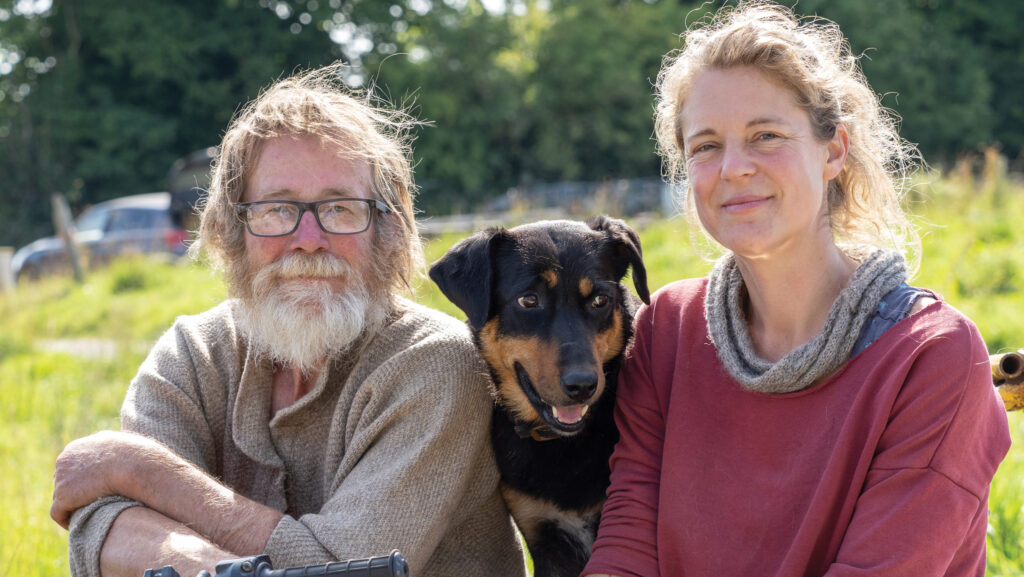
Andy Wear and Jen Hunter © Kathy Horniblow
The flock combines six native British breeds – Shetland, Romney, Bluefaced Leicester, Teeswater, Wensleydale, and Leicester Longwool – to produce soft and lustrous fibres for weaving and knitting.
Recognising the potential in their wool, they launched Fernhill Fibre, promoting their regenerative, chemical-free wool.
They collaborate with UK-based designers and artisans, supplying high-quality fibres to brands such as Bristol Cloth, Garthenor, and Marina Skua.
Their twice-yearly Wool School runs for several weeks, with students learning the entire journey of wool, from blade shearing and fleece grading to spinning, weaving, and felting, providing hands-on training in textile crafts.
“There is a huge discontinuity in the fashion industry, people want traceability but need educating first to see wool as a primary product in the UK,” says Jen.
By breeding for both meat and wool, Jen and Andy promote sustainable, profitable farming.
They lead by example, sharing skills and training others to blade shear and add value to their wool through timely shearing, grading, and sorting for saleable products.
South East England Fibreshed
Co-founded by Deborah Barker, Harriet Miller, and Gala Bailey-Barker, South East England Fibreshed (SEEF) is developing a local regenerative fibre system across several counties including Berkshire, Oxfordshire, Sussex and Greater London.
Its goal is to root fashion in farming, helping fibre producers build access to markets that are often inaccessible in opaque supply chains.
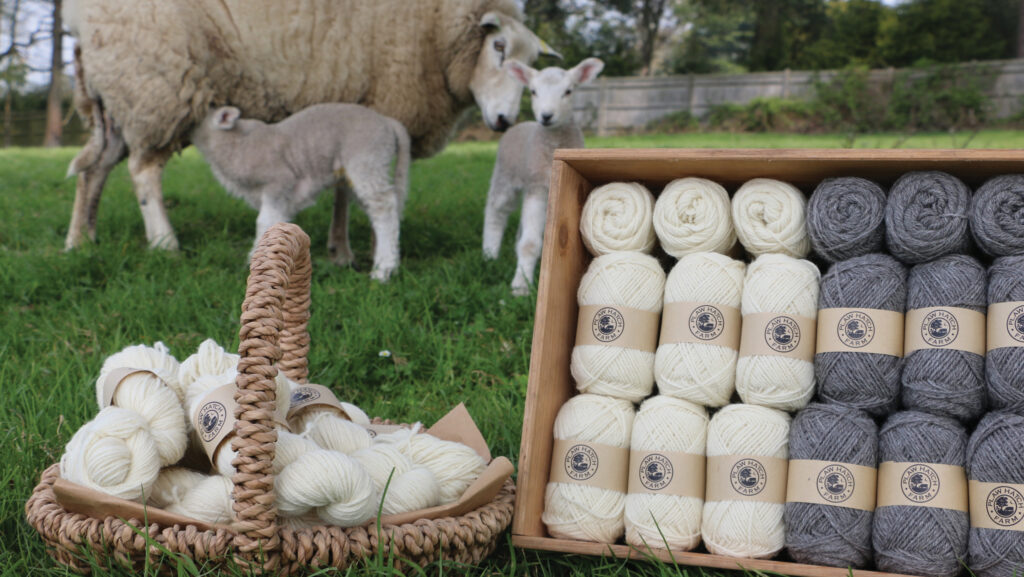
© Gala Bailey-Barker/SEEF
SEEF mentors farmers in processing and marketing sheep wool – valuing it not just by weight but also quality, provenance and ecological value.
Its Farming Fashion: Wool guide, developed with South West England Fibreshed, helps producers navigate production decisions and avoid common pitfalls.
Deborah welcomes contact from farmers who are interested in starting a conversation with designers looking to source locally farmed wool.
“Don’t rush into it and definitely read the guide,” she advises.
“It can be disheartening when things don’t quickly pick up, but you need to be proactive, patient, and build confidence and necessary trust.”
Created in a partnership between SEEF and designer Phoebe English, the Yellow Jumper is a fully traceable garment made using regenerative fibres from SEEF’s network.
The jumper currently features in the Design Museum’s “Tomorrow’s Wardrobe” exhibition in an effort to create public awareness of soil-to-skin fashion.
The Wool Library
Maria Benjamin and John Atkinson are farmers, based at Nibthwaite Grange in the Lake District. They embarked on their entrepreneurial journey in 2015 by introducing rare-breed sheep, including Castlemilk Moorit and later Teeswaters, to their farm.
This was the starting point for a collaboration with knitwear design expert Dr Zoe Fletcher, who wanted to promote British wool within fashion.
Together, they co-founded the Wool Library, an educational initiative designed to reconnect the fashion world with the overlooked potential of British wool.
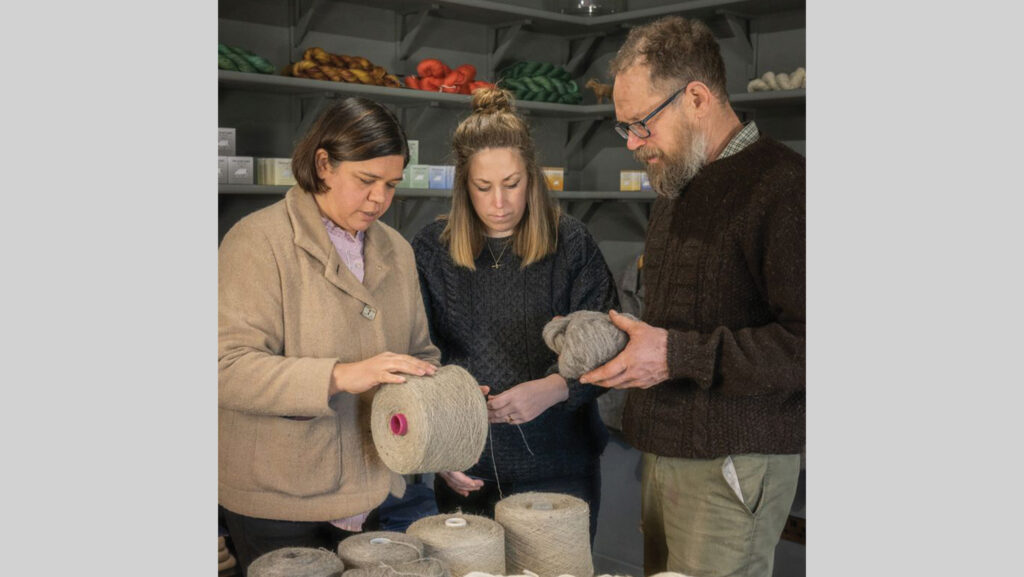
Maria Benjamin (left), John Atkinson and Dr Zoe Fletcher
Maria explains: “People in fashion aren’t encouraged to use British wool or any natural fibres; the Wool Library is educational on why these are unparalleled resources.”
The Wool Library collaborates directly with more than 25 farmers and wool businesses, guiding the entire wool supply chain from land management and ethical sourcing, to product design.
Through the development of distinctive breed-specific yarns and on-farm fibre days for UK and international visitors, it is creating long-term relationships based on trust and visibility.
Its initiative, Farmer’s Yarn, which began as a wool festival, has evolved into a membership scheme that gives customers access to traceable British wool, while offering farmers a better return.
As Maria puts it: “We are not only educating people about the British wool industry, but also reshaping the narrative around British wool.”
Wool quality
Different wool types are suited to different end uses depending on fibre diameter, texture, and breed.
- Fine wool (29–35 microns) From downland breeds such as Suffolk and Portland –springy and used in fabric, tweed, bedding and knitwear.
- Medium wool (31–35 microns) From breeds such as Romney – soft but durable, ideal for apparel yarns, tweeds and carpets.
- Crossbred wool (29–35 microns) From breeds such as Mule and Masham – varies by parentage and makes up 25% of the UK clip. Used in knitwear blends, insulation, carpets and packaging.
- Lustre wool (26+ microns) Includes Bluefaced Leicester (finest) and Devon and Cornwall Longwool (coarser) –shiny, curly wool for tailoring, hand knitting, and upholstery.
- Hill wool (30–33 microns) From breeds such as Kerry Hill and Cheviot – ranges from soft to crisp with some kemp, used in yarns, bedding, tweeds and carpets.
- Mountain wool (35+ microns) From hardy breeds such as Blackface and Swaledale
– bulky, resilient wool for carpets, underlay and packaging. - Naturally coloured wool (30–35+ microns) From breeds such as Jacob and Herdwick – colour adds richness to artisanal goods, used in cloth, hand knitting,
and insulation.
Source: British Wool Marketing Board
British Pasture Leather
Elsewhere, the same principles are being applied to leather. British Pasture Leather, founded by Alice Robinson and Sara Grady, has created a supply chain that links leather directly to local agriculture.
The pair are the only producers of leather from hides of cattle raised on regenerative UK farms, offering full traceability and a deeper understanding of the material’s environmental context.
British Pasture Leather hosts Field Days, where fashion and design professionals visit regenerative farms to learn about everything from soil health to pasture management.
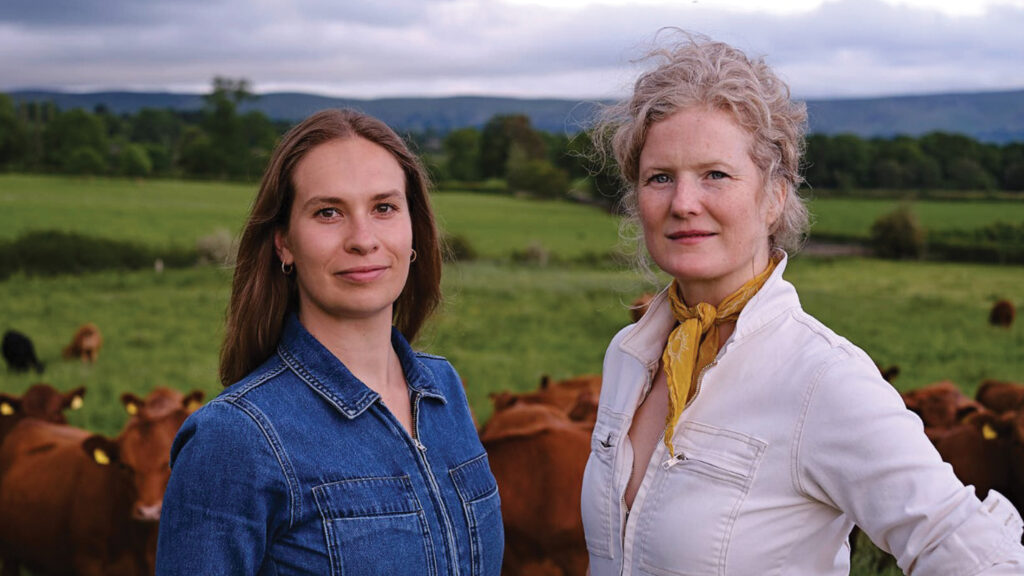
Alice Robinson (left) and Sara Grady © Jason Lowe
The initiative includes a collaboration with heritage brand Mulberry, which is seeking to establish an end-to-end UK leather supply chain using the British Pasture Leather network.
Sara says: “British Pasture Leather supports farmers in multiple ways: by making a voluntary contribution to the farms whose hides are used in their general production, by drawing awareness to and appreciation of British agriculture, and by providing a service for farmers who wish to have hides from their own herd tanned and returned as leather for special projects.”
Case study: Great Cotmarsh Farm, Wiltshire
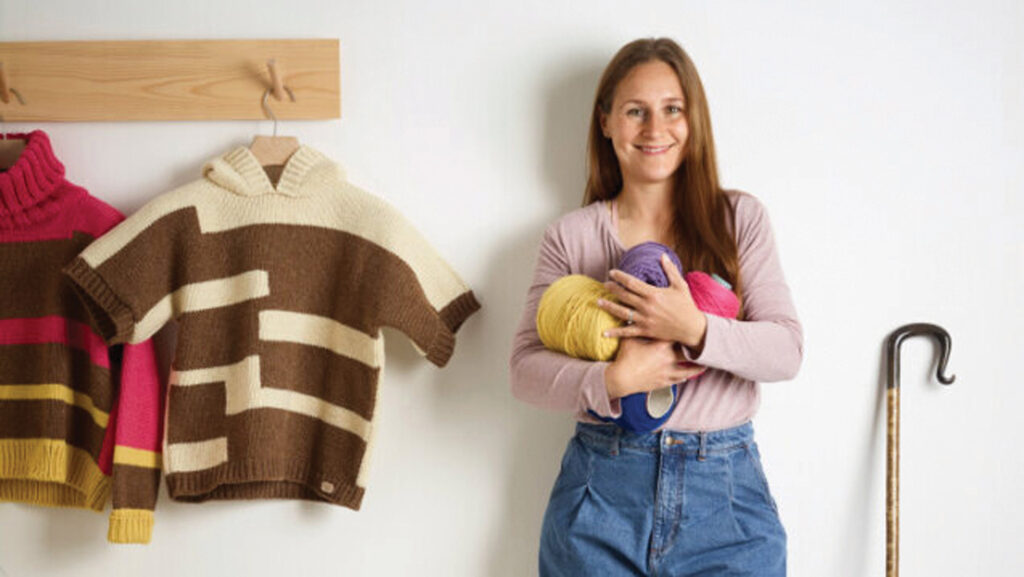
Katie Allen © Studio Article
The search for a diversification project that makes use of undervalued wool, combined with a passion for addressing the climate crisis, led Katie Allen at Great Cotmarsh Farm to launch a unique sustainable fashion business, with her garments selling for up to £399 apiece.
First-generation farmer Katie began her journey in 2010 on a 8ha smallholding in Cornwall, later relocating to the Cotswolds with her sheep to join her now husband, James.
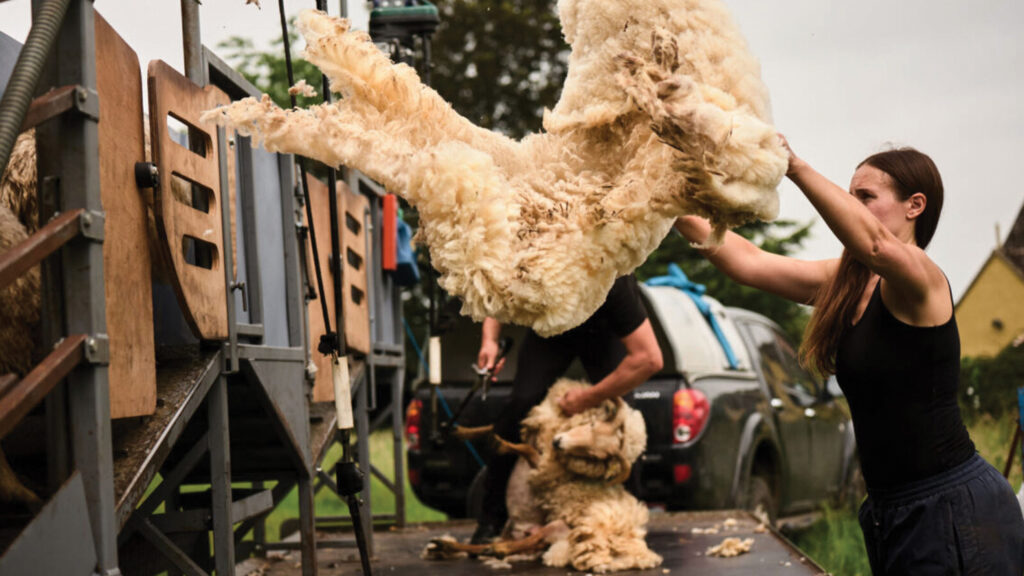
© Studio Article
After a decade of working as graziers, the couple took on Great Cotmarsh Farm in Wiltshire in December 2022.
Initially producing lamb for a small on-site farm shop, Katie saw potential in the fleeces.
Her Castlemilk Moorit and Portland sheep display the variety of British wool. Portland wool is fine with lots of bounce, perfect for dyeing, but Castlemilk Moorit is a natural hazelnut colour that doesn’t have the same strength.
“As farmers, we’re struggling to get any value for our wool clip,” says Katie. “At the same time, we’re wearing fast fashion made from horrible, toxic materials. The solution to both problems is sitting right here within our farming systems.”
Forward thinking
With no background in fashion, the first challenge was to learn the craft. In her early 30s, Katie joined an A-Level textile design cohort and later completed a master’s degree in Fashion and Textile Design at Bath Spa University.
With her new skills, Katie set about producing high-quality fibre, managing every detail from the sheep’s diet to shearing to achieve the best fleece possible.
After shearing in mid-July, the fleeces are sorted to remove unwanted fibre, vegetation and dirt and are then taken to a mill in Cornwall, where they are weighed, processed and spun.
The wool returns to the farm washed and ready for use as a chunky knitting yarn.
Adding colour is the final stage of processing the yarns, and this is done either by Sophie Holt from Pigment Organic Dyes in Devon or with Katie’s home-grown plant dyes.
All of the products are made by Katie in her studio on the farm, using a knitting machine.
Each garment is hand-finished using a process called “fully fashioned”, which means they have been shaped and made in sections. This is a no-waste technique, using every piece of yarn.
Teaching sustainability
On the farm is a newly built classroom to teach others about the importance of sustainable fashion in Katie and James’ programme, “Fashion as a Force for Nature”.
More than 200 textile and fashion students from local sixth form colleges to London-based universities are visiting the farm to connect their fashion practice with the soil.
“Trying to battle with the vast global marketplace is hard enough without having the passion and knowledge of wool,” says Katie.
James is also building the UK’s first micro-scale tannery for cattle hides – Cotmarsh Tannery.
This technique involves using natural vegetable tannins to alter the protein structure of the hide, turning it into leather.
They will experiment by adding leather goods to the brand and ensuring traceability, down to the individual animal, and high quality.
The tannery will also supply other brands looking for leather with strong transparency credentials.
Katie says there is a bright future for the farming fashion sector as a whole, with demand from industry and consumers for goods with sustainability credentials.
She would like to see the farm-to-fibre ethos one day be as popular as farm-to-fork.
Buyers embrace natural fibres at county show
Natural fibres such as wool, cotton and linen took centre stage at the South of England Show this year.
Exhibitors showcased collections that struck a balance between function and flair, from well-cut wool jackets to traditional tweeds.
At the Joules second-hand and returns stall, crowds sifted through rails of pre-loved garments in search of wardrobe staples.
Traceability and local craftsmanship were strong selling points too.
At City Cows, Nick Pole shared that demand for British-made goods remains high, with his Chipping Norton-based business selling more than 3,000 leather handbags annually.
“People really care where their products come from,” he says.
Keeping your cool
Wool, more than any other fibre, offers breathability, comfort, and even temperature regulation. “Wool breathes, which people forget,” says Mark Ellis, from Sussex. “It looks the part, but I’m not sweltering in it.”
Rob Price, a fourth-generation farmer from Dorset, says: “When you wear wool to a show, you’re not just dressing up – you’re standing behind the industry. We bang on about sustainability and provenance – well, there it is on your back.”
Material benefits
When Emily-Jane Bayliss, founder of sustainable knitwear brand Beatrice Bayliss, graduated from the London College of Fashion in 2020, the gap between sustainability and clothing seemed broader than ever.
She took inspiration from her grandfather’s passion for wool and went back to the family farm in the Cotswolds.
Emily started by taking wool from farmers who would have otherwise wasted it. Now, she pays farmers for their fleece to turn into stylish and practical garments.
“Wool is such an underrated material – it’s beautiful, functional and sustainable,” she says.
“I’m passionate about celebrating this incredible fibre, supporting British farmers and artisans, and preserving the traditional techniques that make knitwear last a lifetime.”
So, whether it’s a Harris Tweed coat handed down through generations, or a new wool gilet from a local maker, natural fibres are proving themselves as the ultimate showground essential — weatherproof, hardwearing, and proudly rooted in the British countryside.
Case study: Rampisham Hill Mill, Dorset
“Wool taken from a sheep often has no value without additional processing,” says David Wilkins from Rampisham Hill Mill, a small but growing fibre processor based in Dorset.
Together with wife Ruth, David is helping farmers, businesses and individuals, especially those on a smaller scale, add value to their fleece by offering accessible, tailored sheep wool processing services.
The couple bought their farm 18 years ago. Arable wasn’t viable on their land, and cattle were financially out of reach, so sheep became their starting point.
They began with a flock of 40–50, taking fleece to local spinners and getting what David describes as “pocket money prices”.
But the potential of wool stuck with them. They have launched an ambitious eight- to 10-year plan to develop Rampisham Hill Mill into a dedicated facility for farmers.
They are supporting larger farms by processing trial batches, helping them explore new markets without committing an entire clip.
Smaller producers or those with several breeds or with coloured sheep often will send multiple separate batches for processing.
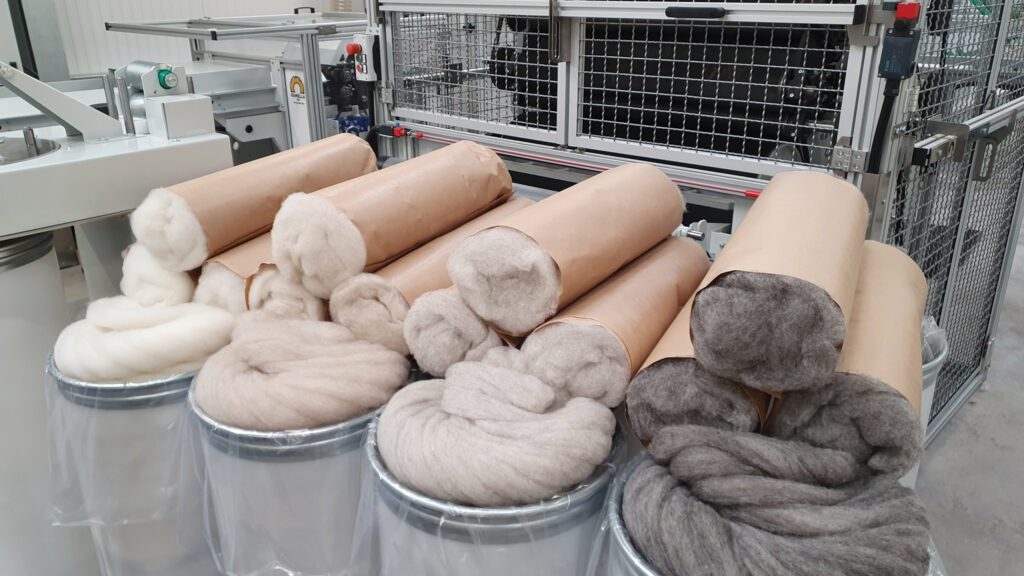
Shetland wool is processed into carded sliver or batts at Rampisham Hill Mill
By having the wool processed into carded sliver (a continuous coil of fibre), batts (a sheet of fibre), or machine spinning the fibre into yarn, producers can sell their finished products directly to hand spinners, felters, quilters or knitters.
Flexibility and logistics are important to the business, with next-day courier options to deliver products across England, Scotland and Wales.
“Locality is huge now,” David explains. “We’re not going to change the industry overnight, but we are quietly showing people that there is value in their fibre when it’s processed well and matched with the right market.”
Rampisham Hill Mill tailors its service to the characteristics of each client’s wool.
“We’re governed by the fibre that comes through the door,” David adds. “But once the idea of local, traceable fibre gets out there, the market is ready for it.”
With growing interest in British wool and increasing demand for traceable supply chains, Rampisham Hill Mill is proving that small-scale processing can have a big impact.
